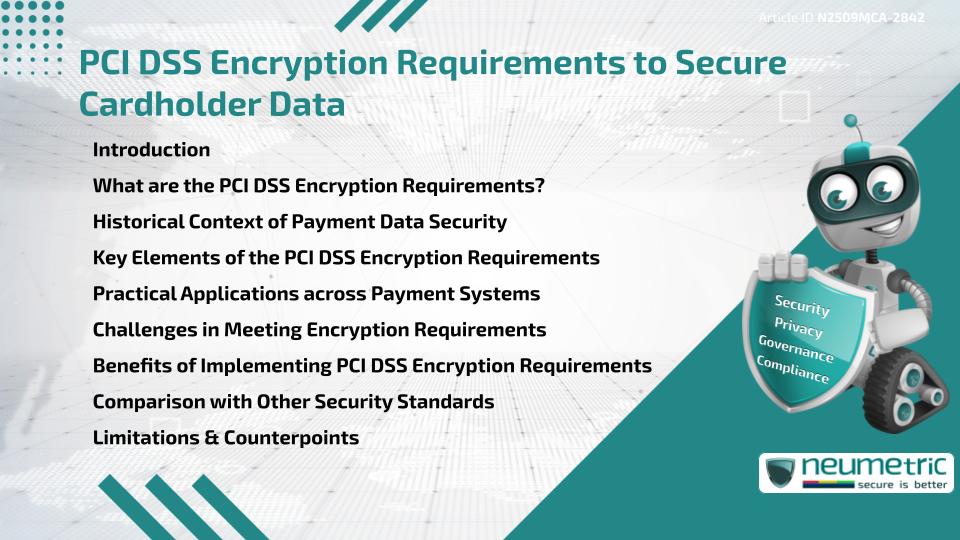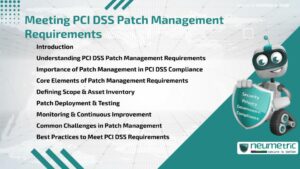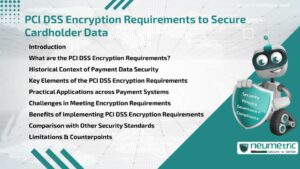Table of Contents
ToggleIntroduction
The PCI DSS Encryption Requirements form a core part of the Payment Card Industry Data Security Standard [PCI DSS], which helps Organisations protect Cardholder Data from Breaches & Misuse. Encryption is vital in preventing unauthorised access during storage & transmission of Sensitive Payment information. By following the PCI DSS Encryption Requirements, businesses not only safeguard Customer Trust but also avoid severe penalties for non-compliance. These requirements apply to all entities that store, process or transmit Cardholder Data, making them critical across Retail, Finance, Hospitality & Online Commerce industries.
What are the PCI DSS Encryption Requirements?
The PCI DSS Encryption Requirements set Standards for protecting Cardholder Data through Encryption & related Key Management Practices. They dictate how Primary Account Numbers [PANs] & Sensitive Authentication data should be secured when stored or transmitted. The requirements also emphasise the use of strong Cryptographic Algorithms, proper implementation & ongoing Key Lifecycle Management to ensure Data Protection.
Historical Context of Payment Data Security
The need for secure payment systems became pressing as card transactions grew in the late twentieth century. In response to a surge in data breaches, major credit card companies collaborated to form the PCI Security Standards Council in 2004. The PCI DSS Encryption Requirements emerged as one of the most effective tools to secure Cardholder Data, ensuring consistency in how Organisations defend against Cyber Threats targeting payment systems.
Key Elements of the PCI DSS Encryption Requirements
The PCI DSS Encryption Requirements focus on several important aspects:
- Encryption algorithms: Use of industry-accepted algorithms such as AES or RSA for strong Encryption.
- Key management: Secure creation, distribution, storage & retirement of Cryptographic Keys.
- Data in transit: Encryption of Cardholder Data during transmission over public or untrusted networks.
- Data at rest: Protection of stored Cardholder Data through Tokenisation, Truncation or Encryption.
- Access Control: Restricting Decryption privileges to authorised Personnel only.
These elements collectively ensure Cardholder Data remains secure across its lifecycle.
Practical Applications across Payment Systems
The PCI DSS Encryption Requirements apply to Merchants, Payment Processors & Service Providers alike. For example, Online Retailers use Encryption to secure checkout pages, while Banks Encrypt stored Cardholder Databases. Payment gateways apply these measures to secure transactions moving across networks. Even point-of-sale systems rely on Encryption to ensure that card data is safe from interception at the moment of swipe or tap.
Challenges in Meeting Encryption Requirements
Despite their importance, the PCI DSS Encryption Requirements are not without challenges. Smaller businesses may struggle with the cost of implementing advanced Cryptographic solutions. Technical complexities such as Key Management or updating Legacy Systems to meet current Standards often pose hurdles. Additionally, Organisations must ensure staff are trained in proper handling & maintenance of Encryption processes.
Benefits of Implementing PCI DSS Encryption Requirements
Complying with the PCI DSS Encryption Requirements yields several benefits. Organisations reduce the Risk of Data Breaches, thereby avoiding costly fines & reputational damage. Compliance builds Customer confidence, as Consumers trust businesses that demonstrate strong Data Security practices. Moreover, adhering to these requirements streamlines Audits & fosters smoother relationships with Payment brands & Banks.
Comparison with Other Security Standards
Other Standards, such as ISO 27001 or NIST recommendations, also address Data Protection. However, the PCI DSS Encryption Requirements are specifically designed for payment card data, making them more prescriptive for Financial transactions. While ISO & NIST Frameworks provide broader guidelines, PCI DSS ensures a consistent & enforceable approach to protecting sensitive payment information.
Limitations & Counterpoints
Although effective, the PCI DSS Encryption Requirements do not eliminate all Risks. Cybercriminals may exploit System Misconfigurations or human errors despite strong Encryption. Additionally, compliance can be resource-intensive for smaller entities. Some critics argue that the Framework is rigid & may not adapt quickly to evolving technologies. Therefore, organisations must complement PCI DSS with layered Security Measures for complete protection.
Conclusion
The PCI DSS Encryption Requirements provide a robust foundation for securing Cardholder Data across industries. By mandating strong Encryption, Key Management & Access Controls, they help Organisations maintain Compliance while protecting Customer Trust.
Takeaways
- The PCI DSS Encryption Requirements secure Cardholder Data during storage & transmission.
- They emphasise strong Encryption algorithms & effective Key Management.
- Implementation applies to Merchants, Service Providers & Financial institutions.
- Compliance challenges exist, especially for smaller businesses.
- PCI DSS complements but does not replace broader Data Security practices.
FAQ
What are the PCI DSS Encryption Requirements?
They are Standards within PCI DSS that mandate strong Encryption & Key Management to protect Cardholder Data.
Do the PCI DSS Encryption Requirements apply to all businesses?
Yes, any organisation that stores, processes or transmits Cardholder Data must comply.
What algorithms are acceptable under the PCI DSS Encryption Requirements?
Commonly accepted algorithms include AES, RSA & other Industry-approved methods.
How is data protected at rest under PCI DSS?
Data at rest must be protected using Encryption, Truncation, Masking or Tokenisation.
Are Small Businesses required to comply with the PCI DSS Encryption Requirements?
Yes, Compliance is mandatory regardless of business size, though implementation may vary.
What happens if an organisation does not comply?
Non-compliance can lead to heavy fines, loss of payment processing privileges & reputational damage.
How often should Encryption keys be rotated under PCI DSS?
Keys must be rotated regularly according to PCI DSS guidelines to prevent misuse.
Need help for Security, Privacy, Governance & VAPT?
Neumetric provides organisations the necessary help to achieve their Cybersecurity, Compliance, Governance, Privacy, Certifications & Pentesting needs.
Organisations & Businesses, specifically those which provide SaaS & AI Solutions in the Fintech, BFSI & other regulated sectors, usually need a Cybersecurity Partner for meeting & maintaining the ongoing Security & Privacy needs & requirements of their Enterprise Clients & Privacy conscious Customers.
SOC 2, ISO 27001, ISO 42001, NIST, HIPAA, HECVAT, EU GDPR are some of the Frameworks that are served by Fusion – a SaaS, multimodular, multitenant, centralised, automated, Cybersecurity & Compliance Management system.
Neumetric also provides Expert Services for technical security which covers VAPT for Web Applications, APIs, iOS & Android Mobile Apps, Security Testing for AWS & other Cloud Environments & Cloud Infrastructure & other similar scopes.
Reach out to us by Email or filling out the Contact Form…





